 W
WThe Battle of Boratycze took place on September 14, 1939, during the Invasion of Poland. Polish 24th Infantry Division, commanded by General Kazimierz Fabrycy, and supported by units of Border Protection Corps, clashed with German 2nd Mountain Division. The battle took place near the village of Boratycze, located between Przemysl and Lwów in the Second Polish Republic.
 W
WThe Battle of the Border refers to the battles that occurred in the first days of the German invasion of Poland in September, 1939. The series of battles ended in a German victory, as Polish forces were either destroyed or forced to retreat.
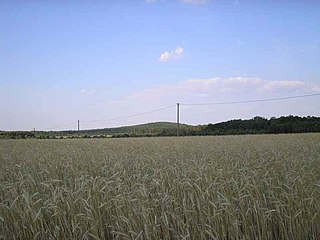 W
WBattle of Borowa Góra refers to the series of battles from 2 to 5 September 1939 that took place near the Góry Borowskie hills, south west from Piotrków Trybunalski and east of Bełchatów. The battle, fought between the Wehrmacht and the Polish Army in the vicinity of Łódź, was a direct consequence of the Battle of the Border, an early part of the German Invasion of Poland
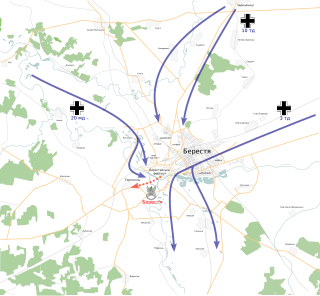 W
WThe Battle of Brześć Litewski was a World War II battle involving German and Polish forces that took place between 14 and 17 September 1939, near the town of Brześć Litewski. After three days of heavy fights for the stronghold in the town of Brześć, the Germans captured the fortress and the Poles withdrew.
 W
WThe Battle of the Bzura was the largest Polish counter-attack of the German Invasion of Poland, fought between the 9th and 19th of September. The battle took place west of Warsaw, near the Bzura River. It began as a Polish counter-offensive, which gained initial success, but the Germans outflanked the Polish forces with a concentrated counter-attack. This weakened Polish forces and the Poznań and Pomorze Armies were destroyed. Western Poland was now under German rule. The battle has been described as "the bloodiest and most bitter battle of the entire Polish campaign". Winston Churchill called the battle an "ever-glorious struggle".
 W
WThe Battle of Częstochowa was one of the first battles of the Invasion of Poland during World War II. It took place on September 1–3, 1939.
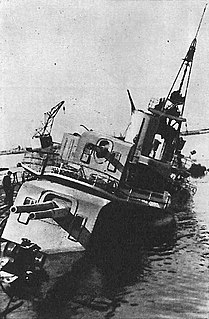 W
WThe Battle of Danzig Bay took place on 1 September 1939, at the beginning of the invasion of Poland, when Polish Navy warships were attacked by German Luftwaffe aircraft in Gdańsk Bay. It was the first naval-air battle of World War II.
 W
WThe Defence of the Polish Post Office in Danzig (Gdańsk) was one of the first acts of World War II in Europe, as part of the September Campaign. On September 1, 1939, the Invasion of Poland was initiated by Germany when the Schleswig-Holstein battleship opened fire on the Polish-controlled harbor of Danzig, around 04:45–48 hours. Danzig paramilitaries and police, supported by Germany, immediately joined the offensive to take full control of the city, by capturing the Polish post office. Polish personnel defended the building for some 15 hours against assaults by the SS Heimwehr Danzig, local SA formations and special units of Danzig police. All but four of the defenders, who were able to escape from the building during the surrender, were sentenced to death by a German court martial as illegal combatants on October 5, 1939, and executed.
 W
WBattle of Gdynia was one of the major battles in northern Poland during the Invasion of Poland of 1939. The Germans' main push towards Gdynia began on 8 September and they captured Gdynia six days later on 14 September.
 W
WBattle of Grudziądz was a military engagement between German and Polish forces during the early days of the Invasion of Poland in September 1939. It started on 1 September and ended with a German victory on 4 September. German historiography has dealt with the fighting in the larger context of the Battle of Tuchola Forest.
 W
WThe Battle of Hel was a World War II engagement fought from 1 September to 2 October 1939 on the Hel Peninsula, of the Baltic Sea coast, between invading German forces and defending Polish units during the German invasion of Poland. The defense of the Hel Peninsula took place around the Hel Fortified Area, a system of Polish fortifications that had been constructed in the 1930s near the interwar border with the German Third Reich.
 W
WThe Battle of Husynne was an armed engagement fought on 24 September 1939 between the Polish Army and the Red Army during the Nazi and Soviet invasion of Poland. The battle took place in the vicinity of Husynne manor, some 7 kilometres (4.3 mi) to the north east of the town of Hrubieszów. In the effect of a swift cavalry charge, a Polish improvised cavalry unit broke through Soviet infantry lines, but were then decimated by Soviet tanks.
 W
WThe Battle of Jaworów was a battle fought between the German forces and elements of the Polish Małopolska Army during the German Invasion of Poland. It took place from 14 to 16 September 1939 in the vicinity of the town of Jaworów. In the effect of a two-day assault, the Polish forces broke through the German line of defence on their way towards the city of Lwów. The engagement is best known for the destruction of one battalion of three battalions of SS-Germania regiment together with the capture of the heavy equipment of the entire regiment.
 W
WThe Battle of Jordanów took place on 1–3 September 1939, during the Invasion of Poland and the opening stages of World War II. It was fought between the German XVIII Panzer Corps of Gen.E.Beyer and the Polish 10th Motorized Cavalry Brigade under Col. Stanisław Maczek.
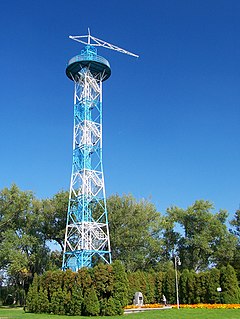 W
WThe Defense of Katowice was carried out by small groups of irregular Polish militia on 3–4 September 1939 during the German invasion of Poland. German troops secured the city by the end of 4 September.
 W
WThe Battle of Kępa Oksywska took place in the Oksywie Heights outside the city of Gdynia between 10 and 19 September 1939. The battle, fought by the Polish Army and the German Wehrmacht, was part of the Polish September Campaign during World War II. It was one of the bloodiest battles of the campaign, with Polish KIA losses reaching roughly 14% of all the forces engaged.
 W
WThe Battle of Kobryń was one of the battles of the Invasion of Poland. It was fought between 14 and 18 September 1939, between the German XIX Panzer Corps of General Heinz Guderian and the improvised Polish 60th Infantry Division "Kobryn" of Colonel Adam Epler. It was fought concurrently with the Battle of Brześć Litewski.
 W
WThe Battle of Kock was the final battle in the invasion of Poland at the beginning of World War II in Europe. It took place between 2–5 October 1939, near the town of Kock, in Poland.
 W
WThe charge at Krojanty, battle of Krojanty, the riding of Krojanty or skirmish of Krojanty was a cavalry charge that occurred during the invasion of Poland in the Second World War. It took place on the evening of 1 September 1939 near the Pomeranian village of Krojanty. Polish soldiers advanced east along the former Prussian Eastern Railway to railroad crossroads 7 kilometres from the town of Chojnice (Konitz) where elements of the Polish cavalry charged and dispersed a German infantry battalion. Machine gun fire from German armoured cars that appeared from a nearby forest forced the Poles to retreat. However, the attack successfully delayed the German advance, allowing the Polish 1st Rifle battalion and Czersk Operational Group to withdraw safely.
 W
WBattle of Lasy Królewskie refers to the battle on 1 September 1939 near Janowo and Krzynowłoga Mała during the Battle of the Border of the Invasion of Poland.
 W
WThe Battle of Łódź was fought on September 6–8, 1939, between the armies of Poland and Nazi Germany in World War II during the Invasion of Poland. The Polish forces were led by General Juliusz Rómmel.
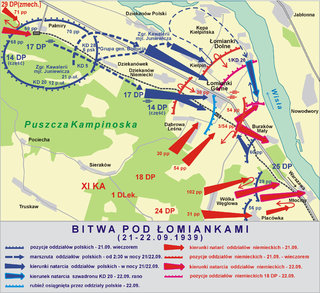 W
WThe Battle of Lomianki was a part of the opening campaign of World War II during the 1939 German invasion of Poland, fought between Polish and German forces. It was a failed counter-offensive attempt by the Polish forces.
 W
WBattle of Łomża was a series of armed engagements during the Nazi German and Soviet Invasion of Poland. The battle took place in and around the town of Łomża, on both sides of the Narew River. Polish forces successfully held a series of pre-First World War forts from repeated German attack before being forced to withdraw due to the position becoming untenable following their losses at the Battle of Wizna and Battle of Nowogród.
 W
WThe Battle of Lwów was a World War II battle for the control over the Polish city of Lwów between the Polish Army and the invading Wehrmacht and the Red Army. The city was seen as the key to the so-called Romanian Bridgehead and was defended at all cost.
 W
WThe Battle of Mikołów refers to the border engagement on September 1 and 2, 1939, that took place in the area of the town of Mikołów, which is located in the Polish part of Upper Silesia, during the early stages of the Invasion of Poland in the Second World War.
 W
WThe Battle of Mława, otherwise known as the Defence of the Mława position, took place to the north of the town of Mława in northern Poland between 1 and 3 September 1939. It was one of the opening battles of the Invasion of Poland and World War II in general. It was fought between the forces of the Polish Modlin Army under General Krukowicz-Przedrzymirski and the German 3rd Army under General Georg von Küchler.
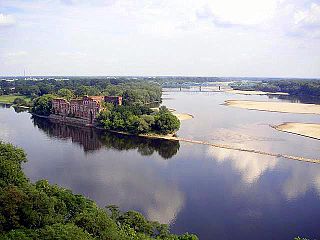 W
WThe Battle of Modlin was a battle that took place during the 1939 German invasion of Poland at the beginning of the Second World War. Modlin Fortress was initially the headquarters of the Modlin Army until its retreat eastwards. From 13 to 29 September 1939, it served as a defensive citadel for Polish forces under the command of General Wiktor Thommée against assaulting German units. The fighting was closely linked with the strategic situation of the Battle of Warsaw.
 W
WThe Battle of Mokra took place on September 1, 1939 near the village of Mokra, 5 km north from Kłobuck, 23 km north-west from Częstochowa, Poland. It was one of the first battles of the Invasion of Poland, of the Second World War and one of the few Polish victories of that campaign, as well as the first German defeat of the conflict.
 W
WBattle of Pszczyna refers to a series of battles between 1 and 2 September 1939 near the town of Pszczyna during the Invasion of Poland. The battle of Pszczyna formed part of the defensive Battle of the Border. The initial, decisive victory of the Polish forces on September 1, 1939 was followed by the crushing defeat on the next day near Ćwiklice, due to a major tactical error on the part of the Polish military command, resulting in premature withdrawal of the entire Armia Kraków from Upper Silesia.
 W
WThe Battle of Radom, also known as the Battle of Iłża, was part of the Invasion of Poland during the Second World War. It lasted from 8 September 1939 to 9 September 1939. Polish troops of the Prusy Army, under General Stanisław Skwarczyński, defended the city of Iłża and the road from Sandomierz to Radom. The Poles were not ready to meet head on overwhelming German XV Army Corps, and were easily defeated after two days of fighting. Prusy Army, in the aftermath of the battle, ceased to exist. Some of the army's units joined other tactical groupings of the Polish armed forces.
 W
WThe Battle of Tomaszów Lubelski took place from 18 September to 20 September 1939 near the town of Tomaszów Lubelski. It was the second largest battle of the Invasion of Poland and also the largest tank battle of the campaign. It resulted in the surrender of Army Krakow on 20 Sept. 1939.
 W
WThe Battle of Tuchola Forest was one of the first battles of World War II, during the 1939 invasion of Poland. The battle began 1 September and ended 5 September with a major German victory. Thanks to poor Polish command and control, as well as German numerical and tactical superiority, the Germans managed to cripple Poland's Army Pomerania and, by breaking through the Polish Corridor, to connect mainland Germany with East Prussia.
 W
WThe siege of Warsaw in 1939 was fought between the Polish Warsaw Army garrisoned and entrenched in Warsaw and the invading German Army.
 W
WThe Battle of Węgierska Górka was a two-day-long defence of a Polish fortified area in south of Silesia during the opening stages of the Invasion of Poland of 1939.
 W
WThe Battle of Westerplatte was one of the first battles of the German invasion of Poland, marking the start of World War II in Europe.
 W
WThe Battle of Wizna was fought between September 7 and September 10, 1939, between the forces of Poland and Germany during the initial stages of invasion of Poland. According to Polish historian Leszek Moczulski, between 350 and 720 Poles defended a fortified line for three days against more than 40,000 Germans. Although defeat was inevitable, the Polish defence stalled the attacking forces for three days and postponed the encirclement of Independent Operational Group Narew fighting nearby. Eventually the tanks broke through the Polish line and German engineers eliminated all the bunkers one by one. The last bunker surrendered around midday on September 10.
 W
WBattle of Władypol was an armed engagement between Poland and the Soviet Union during the Nazi German and Soviet invasion of Poland. It took place on 27 September 1939 near the town of Sambor. It was among the last cavalry battles of 1939 and one of the last large-scale battles in Central Poland. It was won by the Red Army.